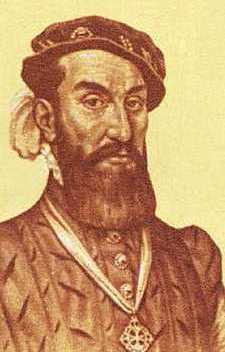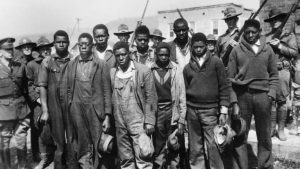The stories of the Spanish conquistadors, of men that believed themselves to be conquerors fighting and exploring for God and gold, are well known. While many of those conquistadors may have seen themselves as bringing civilization to a savage new land, there are those who would argue that this is an incorrect way to view the conquistadors. Instead, they would claim that the conquistadors were encroaching on other people’s culture and religion. One would-be conquistador ended up having a much different experience than most, an experience so different that it forced him to view the Native Americans in a new light, so much so that he eventually advocated for them. This man’s name was Alvar Nunez Cabeza de Vaca.
Cabeza de Vaca was born to a Spanish noble family in 1492. When he was young, his parents died, and he was forced to live with some other relatives. In 1521, he joined the army as an officer after distinguishing himself during military conflict in Italy. In 1527, Cabeza de Vaca embarked on an expedition to explore modern-day Florida, one led by Pánfilo de Narváez. His role in this expedition was that of treasurer for the colony.1 In addition to this, he was also ordered to let the king know of any injustices done by the Spaniards to the Native Americans. The nature of his duty did not change the way that Cabeza de Vaca viewed the Native Americans. At the beginning of the expedition, he still viewed them mainly as savages that were primarily in opposition to Spanish goals. Any respect, if any, that he gave to them was purely that of a rival in regards to their fighting ability.2 This initial attitude would end up standing in very stark contrast to the way that Cabeza de Vaca would eventually come to view them.

The beginning of the Narváez expedition was not off to a great start. Narváez imagined himself as the next Cortez and wanted to follow his example and find a city full of gold. In order to do this, Narváez had decided to pursue rumors of a city of gold, known to the natives only as “Apalachee,” instead of staying closer to the shoreline and their supplies. Narváez was hoping that he would be able to make an endless amount of wealth by conquering this civilization, but when he finally arrived on the shore, all that he and his men found was a small Native American village.3 After this accident, the expedition attempted to meet up with their ship to resupply, but the ship never arrived. It was then that Narváez decided that the crew would make their own ships and sail towards Mexico, hoping to link up with any Spanish forces in the area.4 At this point in the expedition, many of the remaining members, including Cabeza de Vaca, were convinced that their deaths were close and that their situation was dire. At one point, Narváez himself decided to abandon the other ships and survivors in favor of saving his skin. This would be the last time that Cabeza de Vaca, or anyone, would see the would-be conquistador. At the end of it all, there ended up being less than one hundred men left in the expedition, and they all eventually landed on an island that they decided to call “Malhado,” or “Misfortune.” Today, we now know this area as Galveston Island.5
It was on this island that Cabeza de Vaca first encountered the Native Americans in a new light. It was here that a group of Native Americans provided food and shelter to Cabeza de Vaca and his company. Not all of the members of the expedition took advantage of the kindness that was shown to them, however. While many were unable to trust the Native Americans, it was his willingness to trust the Native Americans that most likely saved Cabeza de Vaca’s life, as most of those who did not take their offer ended up dead. After spending the winter on the island, there were only sixteen remaining members of the expedition.6 The entire scenario was a new experience for Cabeza de Vaca, as the only way he had ever viewed the Native Americans before was as rivals. But, much to his amazement, they showed undying compassion and empathy for a group of men that they did not know. Although he originally thought that rescue was coming within a year, Cabeza de Vaca’s experience on the small island was just the beginning of what would happen to him while he lived with the Native Americans.

Cabeza de Vaca would go on to live on Malhado for about four more years while serving as a physician and trader to the tribes there. He realized that his only real chance for survival during this time was to make himself useful to the tribe. Although he had originally refused to become a healer, due to the fact that he viewed the Native American way of healing similar to idolatry, he eventually caved and started to learn their ways of healing due to necessity. He would go on to learn much about Native American culture, not because he was curious, but rather, he was forced to so in order to survive. He learned Native American languages, customs, and what items were valuable to the Native American lifestyle.7 Learning all of these skills ultimately allowed Cabeza de Vaca to survive his experience on Malhado. Over the years, Cabeza de Vaca had to get a new understanding of Native American culture as he was exposed to parts of their lives that he had never even bothered to think about before. This is also when Cabeza de Vaca most likely began embracing the different culture. When he got the opportunity, Cabeza de Vaca focused on writing many of his observations about the Native Americans, mainly on how they worked as a group and not on their individual lives. Indeed, he focused on what they did as a culture and economically above all else. This was most likely the result of the lens of mercantilism through which he often viewed the world, as it was one of the prevailing economic policies in Europe and the region that he was from.8
During his four years there, Cabeza de Vaca also met up with a few of his fellow members from the expedition that were doing similar work with other tribes, Dorantes, Estevanico, and Castillo. These three men were his main connections to his life before living in Malhado. Eventually, Cabeza de Vaca and these men decided on a gamble to leave the island in order to escape from the roles that they had been forced into during their time with the tribes. They made their escape, and, after a few days, were welcomed by a tribe on the condition that they help the tribe as healers. This predicament simply placed the men in the same situation they were in earlier. Nevertheless, they worked as healers to ensure their survival, and these men attributed any of the healing that they performed to God, as they themselves regarded any healing as a miracle.9 It was around this time that Cabeza de Vaca truly seemed to have become sympathetic to the Native Americans. Although he became genuinely worried about their well-being, he still often took offers of wealth from the tribe, and later painted himself and the other Spaniards as saviors to the Native Americans.10
Cabeza de Vaca and the others eventually found themselves well-respected by the Native Americans, and they used that fact to their advantage. In addition to accepting gifts from the tribe, they also asked the Native Americans to bring them to certain places that they wished to go. This may have started as manipulation, but after a while, Cabeza de Vaca focused on using this newfound respect to teach the Native Americans about God.11 Cabeza de Vaca and his compatriots continued to do this until they encountered a group of Spaniards near Mexico. When they finally made contact, Cabeza de Vaca quickly realized that there was a fundamental difference in the way that the Native Americans perceived him and how they perceived the other Spaniards. That is, they regard him as a man who gives back as opposed to one who takes. He also noticed that his view of the Native Americans greatly differed from that of his his fellow countrymen.12 He greeted his fellow Spaniards, and, after some negotiation, they finally decided to send him to Mexico where he rested for a while before returning to Spain.13

When Cabeza de Vaca returned to Spain, he started to write down what had happened to him during his time in the New World. In these accounts, he described his unique experiences with the Native Americans, including their treatment of him and how he worked with them in order to ensure his survival. As a result of his encounter, he was appointed the governor of a province in South America. While there, he tried to treat the Natives with respect, due to his experiences earlier in life. This policy, however, ended up upsetting many of the people he governed, and he was eventually sent back to Spain, where he lost the respect of the Spanish government. Nearing the end of his life, he ended up staying there until he died a broke man with little respect.14 Cabeza de Vaca led an amazing life, and, although it ended in a very non-climatic way, it was nevertheless one filled to the brim with moral and philosophical lessons. The story of Cabeza de Vaca is one that we should learn from: it is a great account of how cultural exchange can change the way that we see people from other cultures.
- Nan Goodman, “Mercantilism and Cultural Difference in Cabeza de Vaca’s ‘Relación,’” Early American Literature 40, no. 2 (2005): 236. ↵
- Mary Doctor, “Enriched by Otherness: The Transformational Journey of Cabeza de Vaca,” Christianity & Literature 58, no. 1 (2008): 8. ↵
- Mary Doctor, “Enriched by Otherness: The Transformational Journey of Cabeza de Vaca,” Christianity & Literature 58, no. 1 (2008): 8. ↵
- “Cabeza de Vaca, Alvar Núñez (1492?-1559?),” American Eras, 50-51. Vol. 1, Early American Civilizations and Exploration to 1600, (Detroit, MI: Gale, 1997), 51. ↵
- Carlos A. Jáuregui, “Going Native, Going Home: Ethnographic Empathy and the Artifice of Return in Cabeza de Vaca’s Relación,” Colonial Latin American Review 25, no. 2 (2016): 181. ↵
- Carlos A. Jáuregui, “Going Native, Going Home: Ethnographic Empathy and the Artifice of Return in Cabeza de Vaca’s Relación,” Colonial Latin American Review 25, no. 2 (2016): 181. ↵
- Mary Doctor, “Enriched by Otherness: The Transformational Journey of Cabeza de Vaca.” Christianity & Literature 58, no. 1 (2008): 13. ↵
- Nan Goodman, “Mercantilism and Cultural Difference in Cabeza de Vaca’s ‘Relación,’” Early American Literature 40, no. 2 (2005): 231. ↵
- Mary Doctor, “Enriched by Otherness: The Transformational Journey of Cabeza de Vaca,” Christianity & Literature 58, no. 1 (2008): 14. ↵
- Mary Doctor, “Enriched by Otherness: The Transformational Journey of Cabeza de Vaca,” Christianity & Literature 58, no. 1 (2008): 16. ↵
- Mary Doctor, “Enriched by Otherness: The Transformational Journey of Cabeza de Vaca,” Christianity & Literature 58, no. 1 (2008): 17-18. ↵
- Nan Goodman, “Mercantilism and Cultural Difference in Cabeza de Vaca’s ‘Relación,’” Early American Literature 40, no. 2 (2005): 247. ↵
- “Cabeza de Vaca, Alvar Núñez (1492?-1559?),” American Eras, 50-51. Vol. 1, Early American Civilizations and Exploration to 1600, (Detroit, MI: Gale, 1997), 51. ↵
- “Cabeza de Vaca, Alvar Núñez (1492?-1559?),” American Eras, 50-51. Vol. 1, Early American Civilizations and Exploration to 1600, (Detroit, MI: Gale, 1997), 51. ↵



97 comments
Kyle Mauldin
this is a great story to hear. you never get to hear about the Spanish and the native Americans get along with each other. It’s also great to see that he tried to change peoples minds about how this people view the native Americans. However, it’s a shame to see people reject his ideas and his experience and get shined away dying as poor old man.
Nicole Ortiz
I remember learning about Cabeza de Vaca when i was in elementary and middle school and I always thought of him as being one of those “bad” conquistadors because of their search of gold. However, this article was able to show another side to Cabeza de Vaca, one in which he was more humble than one might have thought he was. It was really interesting to read this article and find out more about him that i never knew about before!
Addie Piatz
I vaguely remember learning about Cabeza de Vaca and his in-counter with the Native Americans in my middle school history class. I defiantly do not remember how humble the Native Americans were and how they saved his life. I think it is a refreshing story in history because often we let prejudices get in the way. Cabeza de Vaca thought they were savages and yet they still saved him.
Jacob Silva
I have heard the name Cabeza De Vaca before back in elementary school. Prior to reading this article the only thing I had known about him was that he was just an explorer from the era of Columbus. However, out of all the explorers I’ve heard about he definitely is a unique case. Whereas other explorers may have dismissed and outright disrespected Native American culture, he was open-minded and even embraced the culture.
Audrey Uribe
I learned a little bit about him in past history classes. I think the article is very good representation of prejudice and bias opinions. Very clear and informational story. Cabeza De Vaca living with the native American’s for four years changed his perspective. Ignorance separates people when there is no need for division. Unity is the best way to maximize and live happily.
Olivia Tijerina
I am familiar with the meaning that is formed on the article because it gave a perspective that is most unlikely driven during that time. Moreover because of the setting in the article with Cabeza de Vaca we get a perspective in history that is very important in knowing the lives of the Native Americans by their culture and how Native Americans had lived. Overall, the message grasp that Cabeza de Vaca was able to build, through his journey, a perspective that would change him for the rest of his life
Todd Brauckmiller Jr.
To me this sounds like the best part of history, the parts you never hear too often. What really surprised me was how accepting both De Vaca and the tribes of the Native Americans were of each other. Instead of taking, De Vaca chose to give back to the Native tribes by healing their people. Also I find that very surprising considering how many other known travelers did very “questionable” acts. Though I really enjoy learning about De Vaca’s quest and the experiences he encountered, great job.
Kenneth Gilley
While I had heard of Cabeza de Vaca in past history classes, I did not know about the details of his life. It is amazing that he experienced such a dramatic change in his attitudes towards Native Americans after living with them for just four years. This is a good example of how “you can’t judge a book by its cover.” De Vaca thought that the Native Americans were savages and hindrances, but, in reality, they showed him “undying compassion and empathy.” This was a great article!
Sebastian Azcui
This is a great article! It has a lot of detail and the story is great. This story shows how people underestimate others and how their “superiority” is nothing but pure ignorance. It is interesting how Cabeza de Vaca did such an opinion and how he underestimated Latin American cultures and at the end he got saved by them.
Alexander Avina
I only knew a little about Cabeza De Vaca from learning about the early history of the Americas. I wasn’t fully aware of how De Vaca grew fond of the Native American culture and openly accepted it. This is a great example of someone who was open to the culture of others. It seems as though De Vaca was one of the only people to have a more measured and accepting view of the Native Americans, during this time.